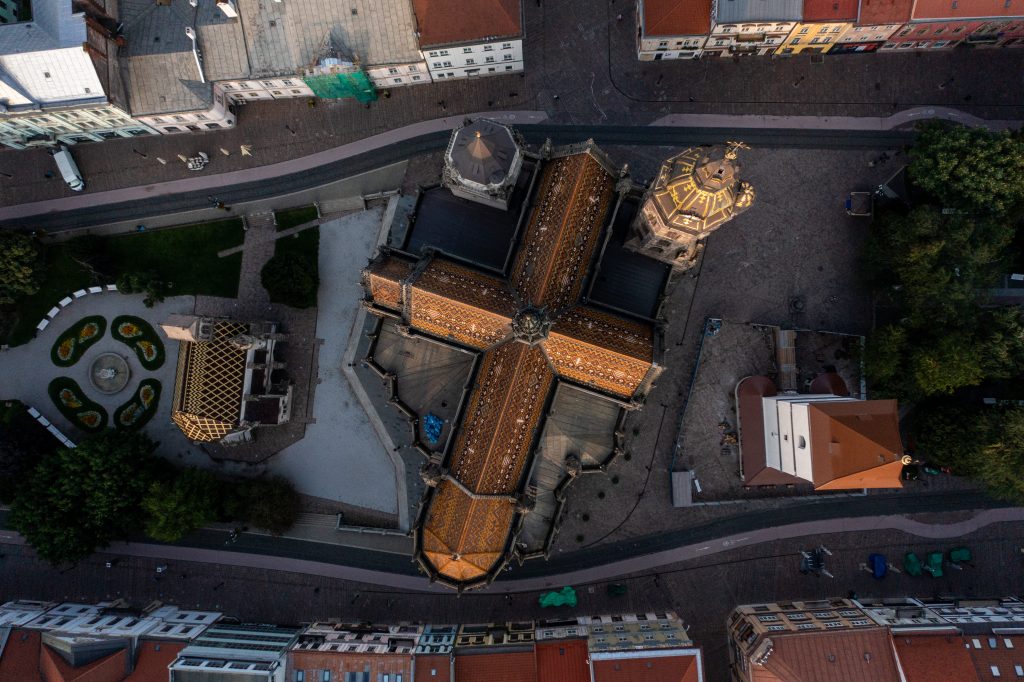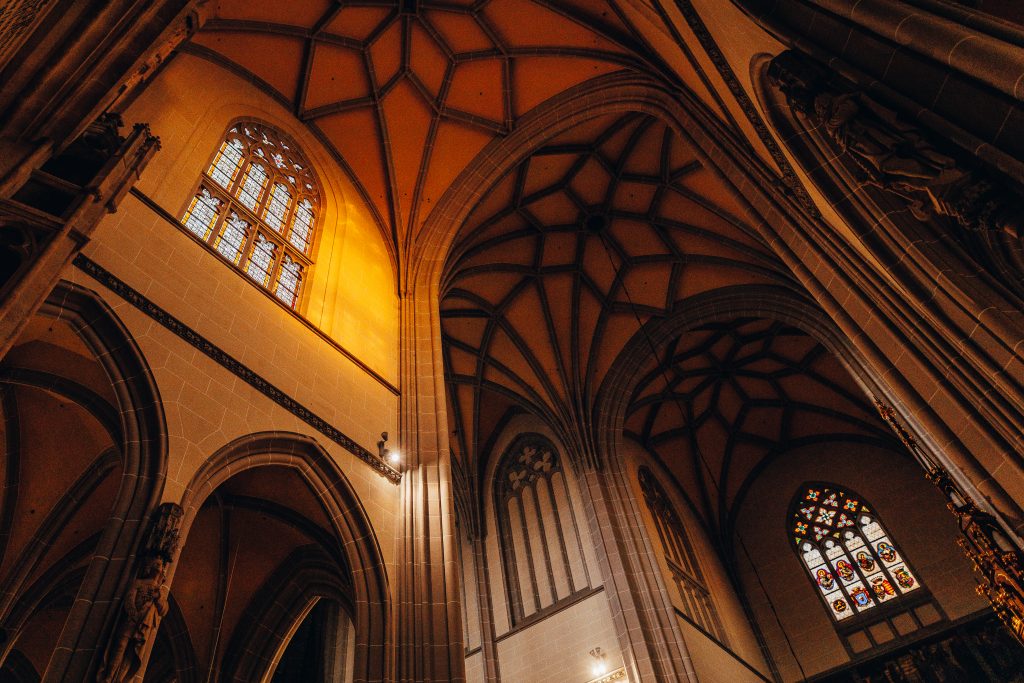
The city as gallery
Layers of time and place
Welcome to the historical centre of Košice, the largest urban preservation area in Slovakia, with the first written mention dating back to 1230, where present-day Košice is mentioned as Villa Cassa. Discover Košice through architecture, stop by anywhere and find yourself on the city’s 800-year timeline. Uncover layers of time and places both horizontally and vertically.
A book with content that reveals its title – Štýly Krásy v Košiciach (Styles of Beauty in Košice) – can take you through the layers of time and architecture in Košice. However, if you want good company on a tour of the city’s open gallery, you can be accompanied directly by its author, Milan Kolcun, the most sought-after guide in Košice. The Regional Information Point (RIB) will be happy to arrange a trip on a selected topic. We guarantee that after completing the sight-seeing you will definitely buy the book in the RIB and Milanko will be happy to sign it for you with an inscription.


Antiquity – Excuse me, does the six go to the Acropolis?
You can find links of this amazing time in the Košice monument reserve. One of the most typical elements of ancient architecture are in the columns that come to mind first when you recall the Acropolis or the Pantheon. The architects were inspired by them to compose seriousness and grandeur of the Forgáč and Csáky – Desewffy’s palace with an antiquity-inspired pillar in front of the entrances. Remains of antiquity may also be found on the decorated facade of the St. Elizabeth Dome, from where 3 faces are looking at you from above with expressive faces. The epic mysteriousness of the ancient muses also affected the sculptural giant in Košice – Mathé. You may see the ancient legacy in his presentation in a carefully selected place – the House of Arts. You may find other ancient muses on Hlavná Street No. 76, there are exactly 9 of them. However, these architectural echoes are just a reminder of the ancient past. The stone embedded in the wall of Urban’s Tower is the most faithful legacy of Rome in Košice. But where did the Roman stone from the 3rd – 4th centuries in Košice come from?
Map with marked ancient elements in Košice.

Romanesque style – Ave visitor, ave Košice!
The cultural legacy of the great disintegrated Roman Empire had been spreading to Europe since the 10th century. According to historical information, after another hundred years, it also manifested itself in the east, in today’s Košice. You will no longer see it in the streets, but it left its imprints in the Gothic St. Elizabeth Dome. It is also the place where the Romanesque parish church stood in the 11th century. By the way, during the reconstruction, the floor plan of the original church with a width of 14 m and a length of 27.8 m was excavated. This is also documented by a drawing of medieval Košice in the archives of the city of Karlsruhe. A bronze baptistery in the Cathedral and a stone lion, which used to be in the southeast corner of the arcade corridor of Urban’s Tower as part of its journey, has remained in the city.
You will experience the atmosphere of a Romanesque royal house in the basement of the Zlatý Dukát hotel, which is named after one of Košice treasures. During the reconstruction in 1950, when the cellars of the house were used by the Jednota Consumer Cooperative, about 10 kilos of gold jewellery were dug out, which the Stern family hid there before their deportation to the concentration camp. The transition from the Romanesque style to the Gothic one may be seen in the oldest church in Košice near the Dominicans; look high on the heads of the columns the oldest parts. Watch the arches, the unbroken ones are Romanesque.
Map with marked Romanesque elements in Košice (St. Elizabeth Dome, Dominicans, Zlatý Dukát Hotel, Urban Tower)

Does Gothic concern you?
Windows, portals and sacral buildings became taller in the Gothic. They reduced the size of man and inflamed him with their monumentality. At that time, the Church already had enough money to pay the builders who had such a “wow” effect on the people. The natural response was to tilt your head down from the admirable starry ceiling, acknowledge your smallness, and put the coin out of your indulgence pocket for your human imperfection. Elegant tall windows and round rosettes decorated with coloured glass (stained glass), which in cooperation with the sun’s rays created a divine show for ordinary people. Pinnacles, crabs, bay windows, gargoyles and other Gothic gems can be found on the facade of St. Elizabeth’s Dome, in the underground Archaeological Museum, St. Michael Chapel, at Alžbetina Stree No. 22 (pinnacles), Hlavná 47 (remains of a Gothic toilet) with the Dominicans and Franciscans. But don’t get confused by the neo-Gothic style, it won’t happen to you with a guide!
Map with marked Gothic elements in Košice

Renaissance – this has not happened in the world yet and it is here again!
Antiquity was copied into historical sheets of the 15th and 16th centuries. In order not to offend the architects, it must be added that the rebirth of the Antiquity was perceived conscientiously by the Italian masters, because repetition is the mother of wisdom. They were able to spread the renown of the Italian art and culture school. The presence of the invited Renaissance masters in this country was also supported by the marriage of Mathias Corvinus to Beatrice of Aragon from Naples. In Košice, compared to Levoča and Prešov, we have preserved less of the Renaissance school, but we are happy to share that small bit with you. On the wall of St. Michael Chapel, there is a portrait of the Burgundian knight Pierre de Roussel, whose remains are moved from the original place under the main altar of St. Elizabeth Dome to the wall of St. Michael Chapel. Copies of paintings by masters Titian and Raphael are proof of the improvement of painting art and its technique. You may admire a copy of Titian on the main altarpiece in the Dominican Church. A section of Raphael’s work (Santa Conversazione) is again on the facade of the house on Hlavná Street No. 37. You may find true Renaissance in the East Slovak Museum, in the work of Renaissance Albrecht Dürer. A witness to the magnificent Renaissance party in this country is in the Levoča House, where Katarína Brandenburg married Gabriel Betlen in 1626. You may read about this “party” with the participation of European monarchs and the number of wedding guests of about two thousand – right in Levočák – on the walls of the current Hostinec Brewery 1542, with beer brewed and culinary food cooked there. By the way, it is considered the oldest inn (unofficial sources). You will definitely discover other traces of the Renaissance with a great guide that will reveal to you more than Google.
Map with marked renaissance elements in Košice

Baroque: Today we have VHF, hold your wigs!
If you don’t see any straight line in the work, only the ripples, curls, shells, and wig hairstyles reaching the height of a three to five-story cake, it’s Baroque. You may meet the Baroque atlases supporting the balcony right at our place in Hadik – Barkóczyi Palace on Hlavná 48, but don’t expect a big debate with them, for that you should go inside the Regional Information Point – there we will wait for you and arrange a tour. You will discover the Baroque in the Premonstratensian Church, originally a Jesuit one, with a masterful eye illusion by Master Erasmus Schrött. Also, on the Baroque “whipped” originally Gothic tower of St. Elizabeth Dome, on the mandorlas in the temple, the Trinity Column at the Dominican Square. But also Immaculata in the centre and other facades of townhouses. The Baroque in Košice will be best discovered in the nonchalant company of a guide.
Map with marked baroque elements in Košice

Artistic style influenced by the curve of human vanity. After the Baroque acclaimed period, it returns to sobriety, symmetry, and geometry. The noble simplicity of Classicism is strongly present in Košice throughout its historic centre. It was influenced by the imperial style of Emperor Napoleon, whose wife Maria Louise, a daughter of the Viennese Emperor Francis, lived in a house on Hlavná 29 where her father moved her out to safety in Vienna. The Emperor’s other children also lived in Košice, at 48 and 68 on Hlavná Street. At No. 68, Marshal Kutuzov also spent a night after losing the battle of the imperial troops near Slavkov. The county house of the historic Abov -Turňa County is a model example of elegant architecture, now being the seat of the East Slovak Gallery. The same architect also designed the Košice City Hall on Hlavná 59. A good example is in the popular Halmi’s Yard with its small shops, also the yard on Hlavná 20 with its typical atmosphere soaked in the aroma of chocolate, tea and spices of a vegan restaurant. From the sacred architecture, make sure to visit the Evangelical Church on Mlynská Street and focus on the dome and the skylight. Doesn’t that remind you of something? Rome? You are in the most beautiful evangelical church in Slovakia.
Map marked with elements of Classicism in Košice.

Art Nouveau: Although Mucha didn’t reach us, he’s here!
There was enough of geometry and precisely drawn shapes! The social order for beauty, supported by the expanding cold industry at the end of the 19th century, changed, and the artists responded to it wonderfully by returning to plant motifs, flowers, and lovely female curves. You will also find this unmistakable style in Košice in St. Elizabeth Dome. The main temple chandelier with glass flowers will shine on it. The extensive fresco in the left part of the church captures the course of the life of Francis II. Rákoczi. Visit the Hotel Slavia for Art Nouveau and thoroughly study its façade with a coffee or a great meal, and do not miss the interior. In all its detailed beauty, you may admire it in the building of the Small Stage of the State Theatre. Do not hesitate and book an Art Nouveau guided tour.
Map with marked elements of Art Nouveau in Košice

Modernity (Pfizer, AstraZeneca?): Tourists, things will get right!
The first third of the 20th century is not that far away that we do not have at least close generational contact with it. We may see the changes that have already come in old family photographs and in nostalgic black and white films. In general, we may say that it was an innovation, a mixture of elements and styles that have emerged in the 20th century until now. The architects of this time relied on functionality and purposefullness, the number of decorations was diminishing. and the implementation of the buildings was supported by the established technical achievements. Thanks to Lajos Oelschläger, the most prominent modernist in Košice, we may also observe traces of that time in Košice. The most significant result of his work is in the hall of the historic Town Hall which served as the cinema hall of the Forum Cinema – later renamed Slovan. At present, we have not come a long way from using the space, which still serves as a cinema hall during the AFF Film Festival and also to guest theatres. His work also includes a building on the corner of Hlavná and Bačíková built streets for the purposes of the Chamber of Commerce and Industry. He also designed a super modern fire squad station on Požiarnická Street and an Orthodox synagogue on Puškinova Street for the people of Košice, where you will also find the Ľudovít Feld Gallery. At the time when skyscrapers were growing overseas, in Košice we had the architect Alexander Skutecký and the construction of an eight-story building on the corner of Hlavná and Pribinova streets. In 1930, the first public building in the modern style was built here – the post office, telegraph and Radiojournal building. And since is was the first, so it is the biggest one! You may admire it in an almost unchanged form, although during the during World War II, it became the target of 4 dropped bombs. 29 bombs fell on Košice that day and there were exactly as many victims. Who bombed Košice on 26 June 1941? This is not clear from history to this day. The guide to Beauty Styles in Košice – Milan Kolcun will tell you about similar stories.
Map with marked elements of modernity in Košice

Socialist realism: Café goers, off you go to mines and factories!
The biggest leap in the demographic development of the city occurred in the 1960s, when the construction of the East Slovak Iron Works was started in Šaca. The population has increased fivefold, and the construction of housing estates, hospitals, community centres, shopping malls, kindergartens, and schools had begun. All this was secured by a grand plan with the Ťahanovce housing estate, which, with all its planned parts, was to become the housing estate with the highest population density in Czechoslovakia. Fortunately, this failed to materialise in the post-revolutionary years, and the markedly mustard-red-beet-painted settlement (according to the original colours of the blocks of flats) ended its expansion. The Victory Arch at the end of the settlement, which was to bridge the already finished part with the planned one, is also important for learning about that time.
Other references of the time include the Soviet Army Monument on Liberators Square. The Prior and Dargov department stores (planned as Domino) are also not to be missed. Many city houses, luxury villas, cultural monuments and quiet streets fell victim. The strongest cry of socialist construction is the White House, home to the Municipal Council. Exactly opposite is another link – the building of the inverted pyramid. In the centre, stop in front of the former trade unions House of Culture, later the Jumbo Centre. They both were visited for the celebration of Nicholas, to the cinema, but also to children’s laser discos. Did you know that In 1976, there was even an international bridge competition?
Map with marked socialist buildings in Košice

Green zones
If you desire to withdraw from the busy promenade, hide in the shade of trees, quietly observe the pulsating centre from the bench by the tulip bed, write a few postcards to your friends at the fountain music, read the last pages of the book lying in the grass carpet or have a little picnic – your oasis of peace is close. If you desire for a real forest, is is only 4 kilometres from the city centre. You can get there on foot, run, scooter, bicycle or public transport in a few minutes.
Parks and relaxation zones:
- City Park
- Park on Hlavná street
- Park at the Signes Fountain
- Park at the Freedom Square
- Wood Market Park
- Park on Moyzesova Street
- Angelinum Park
- Barracks/Culture Park
- Lake
- Furča Forest Park
- Pine Grove
- Ťahanovský Les forest
- Anička
- Bankov
- Alpinka
- Pod Hradovou
- Barca Park
- Hrešná
Botanic Garden
Košice ZOO
Archaeological Open-air Museum in Nižná Myšľa
HORIZONTAL LAYERS OF KOŠICE
If you want to get to know Košice intimately, on the fly – by air, humanly – even though lowly, but also thoroughly in depth, do not hesitate to get to know the city through its horizontal layers. Let’s start from the top. There is nothing better than a compact view from a height, from the perspective of towers, lookout towers, from a basket of hot air balloons. You can roam the middle layer – sidewalks, streets and squares for hours, after all you have visited Košice – a city with the largest urban monument reserve in Slovakia. A city that is an open gallery for its residents and visitors. Wander with a Baedeker in your hand, in the good company of your guides who are ready to answer all your questions. You may also enter the underground bowels of the city via the stairs of the Archaeological Museum at the Lower Gate, through the door of Mikluš Prison or right in St. Elizabeth Dome and St. Michael Chapel. You will learn the most about the mysterious Košice underground with a guide.
Map with points in horizontal layers


























